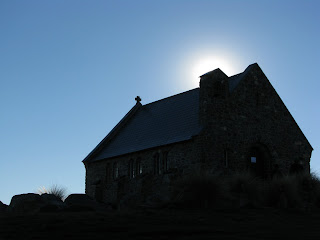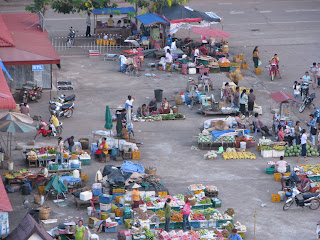 From Tekapo, we headed further inland to another wildly blue lake, Lake Pukaki. From here, we caught our first glimpse of Mt. Cook. The mountain was named after Captain James Cook, one of the early western explorers of the islands, but its original name was Aoraki, which means "Cloud Piercer" in the language of New Zealand's first people, the Maori.
From Tekapo, we headed further inland to another wildly blue lake, Lake Pukaki. From here, we caught our first glimpse of Mt. Cook. The mountain was named after Captain James Cook, one of the early western explorers of the islands, but its original name was Aoraki, which means "Cloud Piercer" in the language of New Zealand's first people, the Maori.  Mt. Cook is the highest mountain in New Zealand - all of Australasia, in fact - and seems to emerge straight up from the belly of the island. You drive along the flat roads that skirt Lake Pukaki almost straight to the base of the Southern Alps. This is one of the best things about New Zealand; everything - from the mountains to the glaciers and more - is amazingly accessible.
Mt. Cook is the highest mountain in New Zealand - all of Australasia, in fact - and seems to emerge straight up from the belly of the island. You drive along the flat roads that skirt Lake Pukaki almost straight to the base of the Southern Alps. This is one of the best things about New Zealand; everything - from the mountains to the glaciers and more - is amazingly accessible.We were very lucky to have seen the Mt. Cook's peak, as it is very often shrouded in clouds. We went on a short hike in the morning to a viewpoint that gave us an  awesome view of the mountain range and the Mueller Glacier. Gil continued trekking further up into the Hooker Valley for a couple of hours, but eventually those infamous clouds developed and he found himself hurrying back to town to escape the windy cold and beat the impending rain.
awesome view of the mountain range and the Mueller Glacier. Gil continued trekking further up into the Hooker Valley for a couple of hours, but eventually those infamous clouds developed and he found himself hurrying back to town to escape the windy cold and beat the impending rain.
 awesome view of the mountain range and the Mueller Glacier. Gil continued trekking further up into the Hooker Valley for a couple of hours, but eventually those infamous clouds developed and he found himself hurrying back to town to escape the windy cold and beat the impending rain.
awesome view of the mountain range and the Mueller Glacier. Gil continued trekking further up into the Hooker Valley for a couple of hours, but eventually those infamous clouds developed and he found himself hurrying back to town to escape the windy cold and beat the impending rain. We spent the night at the cozy YHA in Mt. Cook Village and in the morning went on another hike to check out nearby Tasman Glacier, one of the largest in New Zealand. It looks a bit "dirty" because of the way it has advanced and retreated over time, but was still a spectacular sight to see. There are huge icebergs that fell of f the face of the glacier floating in the terminal lake and we did not realize the scale of them until we spotted a small shape motoring around them, which we finally figure out was a rather large passanger boat!
f the face of the glacier floating in the terminal lake and we did not realize the scale of them until we spotted a small shape motoring around them, which we finally figure out was a rather large passanger boat!
 f the face of the glacier floating in the terminal lake and we did not realize the scale of them until we spotted a small shape motoring around them, which we finally figure out was a rather large passanger boat!
f the face of the glacier floating in the terminal lake and we did not realize the scale of them until we spotted a small shape motoring around them, which we finally figure out was a rather large passanger boat!







.JPG)
.JPG)
.JPG)
.JPG)
.JPG)
.JPG)

.JPG)

.JPG)










